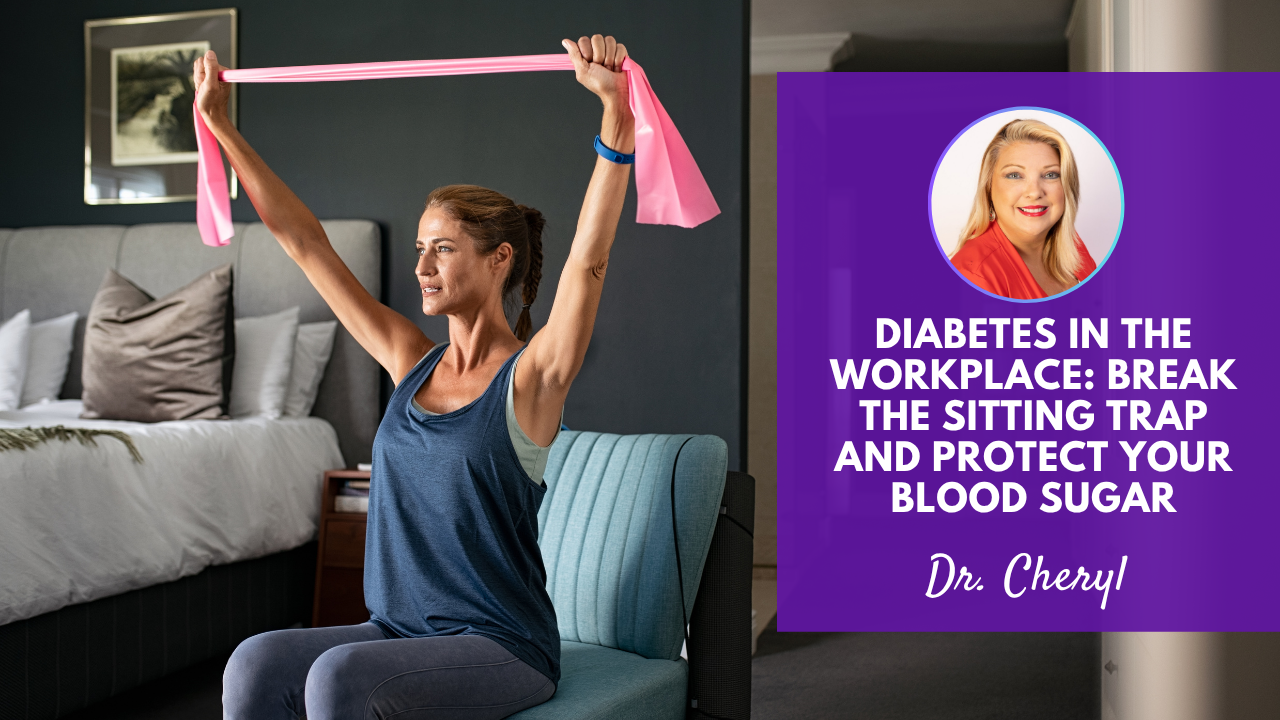
Diabetes in the Workplace: How Nervous System Control Supports Blood Sugar Stability
Today, across the U.S., many families are gathering for Thanksgiving. A day centered on nourishment, reflection, and gratitude. And for many people living with diabetes, it also arrives after months of long workdays, pressure, responsibility, and very little true nervous system rest. Even in a moment meant for pause, the body doesn't always know how to slow down.
That matters because blood sugar isn't controlled by food, medication, and exercise alone. One of the most powerful and overlooked influences is the nervous system. Your stress response quietly shapes how your body uses glucose, how your blood sugar behaves throughout the day, and how you feel physically and emotionally while living with diabetes.
In the workplace, long hours, deadlines, meetings, pressure, and constant decision-making keep the nervous system activated. When the body stays in a stress response for too long, blood sugars rise, even without eating. This is why self-care isn't optional in diabetes management. It is necessary.
How Workplace Stress Affects Blood Sugar
Each deadline, hard conversation, tight schedule, and constant stream of decisions activates the sympathetic nervous system, also known as the fight-or-flight response. This triggers the release of stress hormones, especially cortisol and adrenaline, which signal the liver to release stored glucose into the bloodstream.
This means:
-
Blood sugar can rise even when you have not eaten
-
Glucose volatility increases during stressful work hours
-
Cravings intensify later in the day
-
Energy drops and fatigue rises
For people living with diabetes, this creates a cycle where stress itself becomes a blood sugar driver, independent of food choices.
How the Nervous System Affects Blood Sugar Regulation
The nervous system has two primary states that determine how your body responds to stress and recovery.
Sympathetic State (Fight or Flight)
This state is triggered by stress, pressure, deadlines, tension, and emotional strain. It:
-
Increases cortisol
-
Raises blood sugar for fast energy
-
Suppresses digestion
-
Increases cravings
-
Contributes to fatigue and emotional overwhelm
Parasympathetic State (Rest and Restore)
This state supports healing and balance. It:
-
Improves digestion and glucose use
-
Supports insulin function
-
Lowers heart rate and blood pressure
-
Reduces tension
-
Protects long-term metabolic health
Many people living with diabetes and managing busy schedules, spend most of their day in a chronic fight-or-flight state without realizing it. Over time, this taxes the kidneys, adrenal glands, heart, vision, and nervous system and contributes to burnout and long-term complications.
Harvard Medical School confirms that stress activates the sympathetic nervous system and raises cortisol.
Why the Nervous System Matters So Much
On days meant for connection and rest, many people are surprised by how hard it still feels to truly relax. The mind may slow down, but the body often stays guarded.
For people living with diabetes, months of work pressure, mental load, deadlines, and constant responsibility can keep the nervous system activated even during moments of celebration or reflection.
When the nervous system stays in fight-or-flight for too long:
-
Blood sugar becomes harder to stabilize
-
Fatigue increases
-
Recovery slows
-
Emotional resilience weakens
This is exactly why self-care isn't indulgent - it's protective.
Self-Care Mastery Is Blood Sugar Control
Self-care isn't just relaxation. It's nervous system regulation. It reduces glucose spikes caused by tension and improves your body’s ability to maintain metabolic balance.
You don't need hour-long meditations or lengthy yoga sessions to activate your parasympathetic system. You can reset your nervous system in under two minutes using simple, realistic tools at your desk.
If you want to explore the emotional and physiological connection even further, my article
The Overlooked Self-Care Practice That Supports Mental Health and Blood Sugar explains how daily self-care protects long-term health:
Three Nervous System Resets for Blood Sugar Stability at Work
These micro-practices fit easily into a full workday. Use them between meetings, before presentations, or anytime tension builds.
1. The 2-Minute Breath Reset
Inhale for 4 seconds, hold for 2, and exhale for 6. Repeat 6 to 8 times.
The extended exhale signals safety to your body and supports glucose stability.
2. The Tension Release Scan
Drop your shoulders. Unlock your jaw. Relax your stomach. Release your hands.
Nervous system calm begins in the body, not the mind.
3. The Micro-Break Method
Every hour, pause for 60 seconds. Stand, stretch, or walk across the room. Even brief movement resets circulation and lowers nervous system load.
Why These Simple Actions Lower Blood Sugar
Stress triggers cortisol, which tells the liver to release stored glucose into the bloodstream. When this happens repeatedly without recovery:
-
Blood sugars rise
-
Cravings intensify
-
Energy drops
-
Inflammation increases
Nervous system resets reduce the cortisol load on the body and restore balance. This protects blood sugar and overall metabolic health. Self-care isn't something to do only when life feels calm. It's something to integrate every day, especially at work.
Frequently Asked Questions About Stress and Blood Sugar
How does stress raise blood sugar even without eating?
Stress signals the release of cortisol, which increases blood sugar to provide quick energy for survival, even when no food is consumed.
Can breathing exercises really lower blood sugar?
Breathing exercises activate the parasympathetic nervous system, which lowers cortisol and improves glucose regulation.
What if I do not have time for self-care at work?
When done in small intentional moments, self-care fits into even the busiest schedule and prevents burnout and glucose swings.
On a day centered on gratitude, I invite you to extend that gratitude inward - to your nervous system, your body and to the organs that quietly protect you every day.
Self-care isn't not a reward for when life slows down. It's the structure that allows your body to stabilize, recover, and heal.
And that is exactly why I created How to Live Like a Diabetes Pro guide.
Throughout November for Diabetes Awareness Month, I have been offering this free guide to help people living with diabetes bring more stability to their blood sugar without adding pressure to their lives.
This guide was created for real life - for busy workdays, mental load, family responsibilities, and the constant need to balance it all while living with diabetes.
Your free guide also includes 30 days of complimentary access to my private community, where you will receive daily diabetes wellness tips, weekly trainings, and a live group coaching session with me each month.
They're only available through the end of November and will be taken down at the close of Diabetes Awareness Month.
If you feel ready to support your nervous system and your blood sugar with simple daily structure, you can download your free copy here while it is still available.
Wishing you a peaceful and truly Happy Thanksgiving.
ABOUT THE AUTHOR

Dr. Cheryl
Dr. Ac., C.H., RDH
Dr. Holistic Studies, Dr. Acupuncture
Diabetes Wellness Strategist & Coach
Creator & CEO of Holistic Diabetes Solutions
8 X International Best-Selling Author
As a woman living with diabetes for over 30 years, Dr. Cheryl understands the journey firsthand. When she was diagnosed, she received the same outdated advice her grandmother was given for over four decades, who relied primarily on medication, suffered from deteriorating health and eventually lost her life to diabetes. Fueled by this experience, Dr. Cheryl was compelled to seek a better way. Through countless research studies and trials, she developed the winning holistic approach: the Diabetes Success System which merges traditional wisdom with today’s best holistic self-care practices. It has revolutionized diabetes management by providing a trusted way to maintain consistent and predictable healthy blood sugar levels.
_______________________
PROFESSIONAL DISCLAIMER
The material and content contained in this platform is for overall general diabetes health and education information only. It is not intended to constitute medical advice or to be a substitution for professional medical recommendations, diagnosis or treatment. All specific medical questions or changes you make to your medication and/or lifestyle should be discussed and addressed with your primary healthcare provider. Having the right mindset, doing the right movements at the right times of day, and eating foods that help keep blood sugar, insulin, and inflammation manageable can dramatically reduce your risk of the all-too-common complications of Diabetes, increase your energy levels and have you feeling your best every day.





